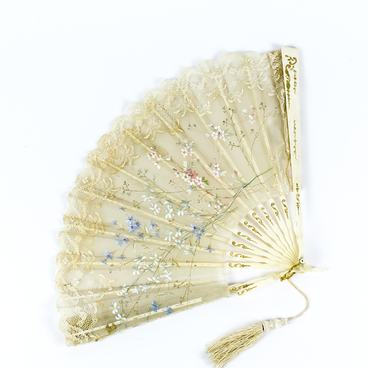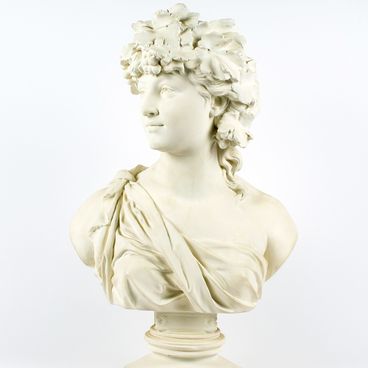The statuette depicting a topless girl with an eagle was made at one of the most famous manufactories in Europe — at the porcelain factory in the town of Meissen. Before the 1917 Bolshevik revolution, this figurine was owned by one of the merchant families of Tetyushi. After the 1917 nationalization, it was confiscated and transferred to the local history museum.
The secret of making hard-paste porcelain was discovered in Saxony by the alchemist Johann Friedrich Böttger and the scientist Ehrenfried Walther von Tschirnhaus. Count von Tschirnhaus, the founder of glass factories, was instructed to supervise the activities of Böttger in 1704 since the latter was kept in Meissen as a prisoner by the decree of Augustus the Strong who was the ruler of Saxony.
Augustus the Strong tried to make gold with the help of numerous alchemists. Böttger successfully demonstrated to him the transmutation of mercury into a precious metal and was awarded the title of baron, while receiving the order to multiply what had been done. However, he was in no hurry to carry out the decree, and in 1701 he was taken into custody. He was forced to continue experiments, but Böttger’s work did not bear fruit.
When it became evident that gold could not be made that way, Augustus the Strong decided to open the production of hard-paste porcelain. After two years of joint work, Böttger and von Tschirnhaus succeeded in making a substance which was similar in its characteristics to Chinese porcelain. Its main components were kaolin — china clay — and Chinese stone, a type of feldspar.
At first, the manufactory produced tableware, vases and sets of porcelain. Gradually, the quality of products increased, new technologies for creating porcelain mass and making paints for painting products appeared. Aristocrats and members of the royal family became interested in porcelain made in Meissen. The manufactory expanded its assortment beginning to produce figurines, small sculptural compositions, writing sets. In the painting of products made of Meissen porcelain, floral ornament prevailed: flowers and fruit trees, dried flowers, pomegranates, “bulbous” decor.
Over time, the richest families in Europe and Russia became customers of the manufactory. Connoisseurs of Meissen porcelain were the Russian Empress Catherine II, the Counts Stroganov, the Princes Yusupov, Carl Faberge as well as many European royals.
By 1770, about 40 percent of all Meissen porcelain exports were delivered to Russia. At the end of the 18th century, the manufactory even allocated special days for the production of only those products that were meant to be sold to Russia.
The secret of making hard-paste porcelain was discovered in Saxony by the alchemist Johann Friedrich Böttger and the scientist Ehrenfried Walther von Tschirnhaus. Count von Tschirnhaus, the founder of glass factories, was instructed to supervise the activities of Böttger in 1704 since the latter was kept in Meissen as a prisoner by the decree of Augustus the Strong who was the ruler of Saxony.
Augustus the Strong tried to make gold with the help of numerous alchemists. Böttger successfully demonstrated to him the transmutation of mercury into a precious metal and was awarded the title of baron, while receiving the order to multiply what had been done. However, he was in no hurry to carry out the decree, and in 1701 he was taken into custody. He was forced to continue experiments, but Böttger’s work did not bear fruit.
When it became evident that gold could not be made that way, Augustus the Strong decided to open the production of hard-paste porcelain. After two years of joint work, Böttger and von Tschirnhaus succeeded in making a substance which was similar in its characteristics to Chinese porcelain. Its main components were kaolin — china clay — and Chinese stone, a type of feldspar.
At first, the manufactory produced tableware, vases and sets of porcelain. Gradually, the quality of products increased, new technologies for creating porcelain mass and making paints for painting products appeared. Aristocrats and members of the royal family became interested in porcelain made in Meissen. The manufactory expanded its assortment beginning to produce figurines, small sculptural compositions, writing sets. In the painting of products made of Meissen porcelain, floral ornament prevailed: flowers and fruit trees, dried flowers, pomegranates, “bulbous” decor.
Over time, the richest families in Europe and Russia became customers of the manufactory. Connoisseurs of Meissen porcelain were the Russian Empress Catherine II, the Counts Stroganov, the Princes Yusupov, Carl Faberge as well as many European royals.
By 1770, about 40 percent of all Meissen porcelain exports were delivered to Russia. At the end of the 18th century, the manufactory even allocated special days for the production of only those products that were meant to be sold to Russia.



